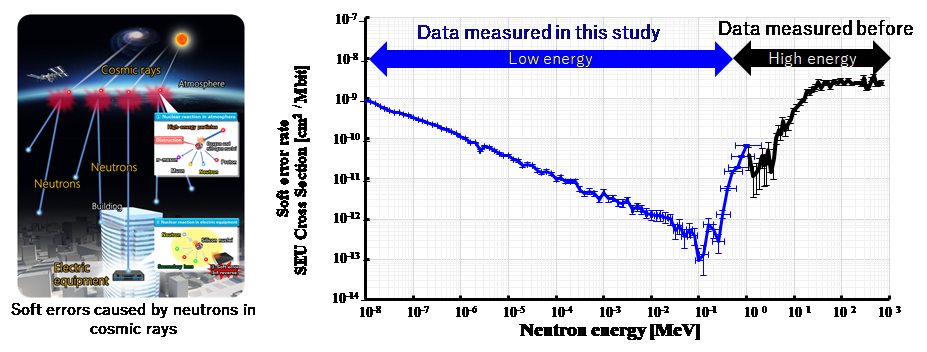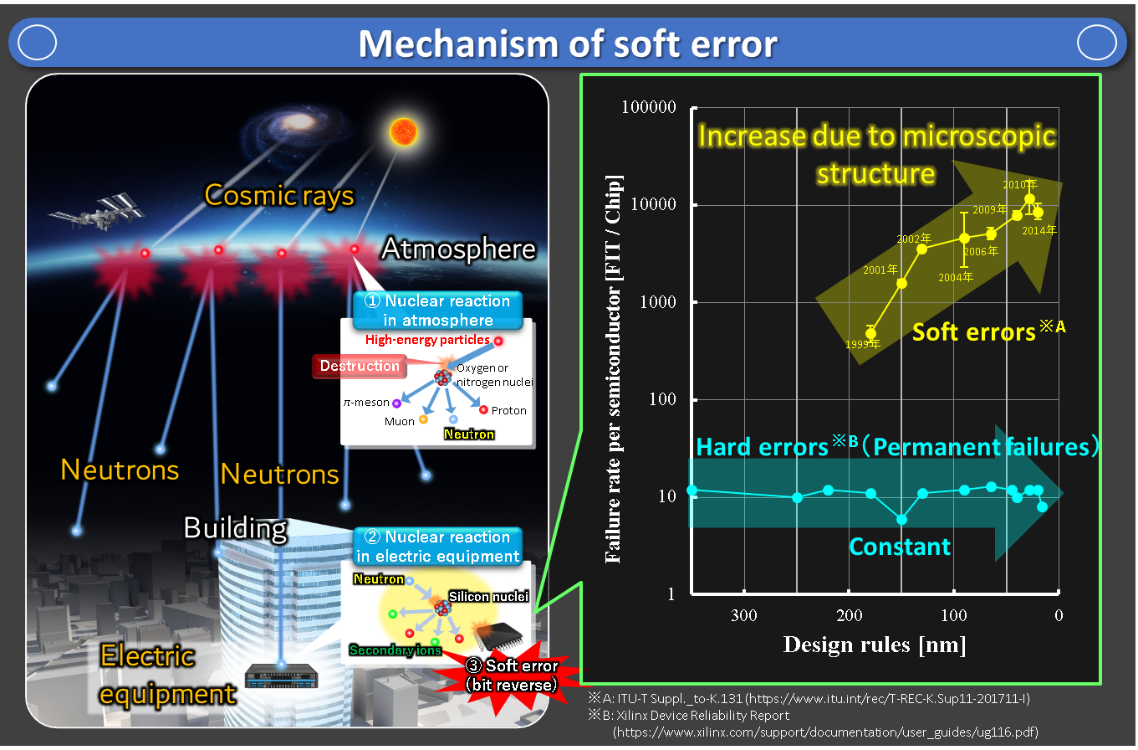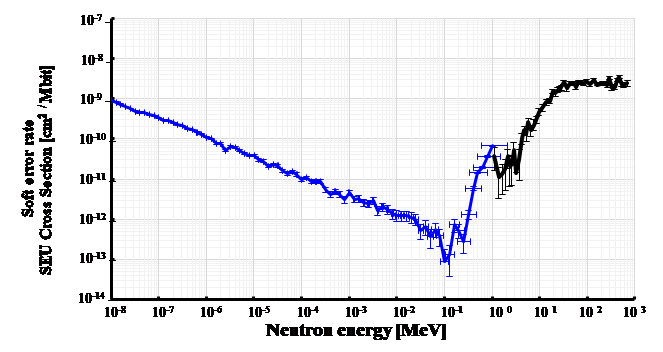Microsoft ends support for Internet Explorer on June 16, 2022.
We recommend using one of the browsers listed below.
- Microsoft Edge(Latest version)
- Mozilla Firefox(Latest version)
- Google Chrome(Latest version)
- Apple Safari(Latest version)
Please contact your browser provider for download and installation instructions.
March 16, 2023
Nippon Telegraph and Telephone Corporation
Hokkaido University
World's first clarification of the complete picture of neutron-induced semiconductor soft-error characteristics
- Construction of a safe social infrastructure through taking countermeasures against malfunctions caused by cosmic rays, which can occur in any electronic equipment -
Nippon Telegraph and Telephone Corporation (Head Office: Chiyoda-ku, Tokyo; President & CEO: Akira Shimada) and Hokkaido University (Sapporo-shi, Hokkaido; President: Kiyohiro Houkin) joined forces and successfully measured semiconductor soft error*1 rates*2 at continuously varying neutron energies in the low energy range of 10 meV to 1 MeV, the range where measurements have not previously been made. The findings reveal, for the first time, a complete picture of the energy dependence of semiconductor soft errors (Fig. 1).
Taking countermeasures against soft errors, which are malfunctions caused by cosmic rays (solar flares and radiation from galaxies), is essential for electronic devices that support our current social infrastructure. Elucidating the soft-error rate for different neutron energies is of prime importance for studying such countermeasures. Going forward, further development of soft-error countermeasures based on these results will lead to safer and more secure social infrastructures.
The study results were published in IEEE Transactions on Nuclear Science on March 15, 2023*3.
 Fig. 1: Soft error rates by low-energy neutrons
Fig. 1: Soft error rates by low-energy neutrons
1. Background
Today, sophisticated electronic devices support our lives in numerous ways, but they increasingly fall victim to soft errors caused by cosmic rays. When cosmic rays, which pour down from space, collide with oxygen or nitrogen atoms in the atmosphere, neutrons are emitted. When neutrons collide with a semiconductor in an electronic device, they can cause "soft errors," a phenomenon whereby the data stored in a semiconductor are changed. Soft errors have the potential to impact social infrastructures, such as communication failures, in seriously adverse ways (Fig. 2).
To address this problem, NTT has already established a soft error testing technology that can reproduce soft errors for evaluation and study of countermeasures. In 2016, NTT Advanced Technology Corporation used this technology to launch its "Soft Error Testing Service"*4. Currently, soft error testing is conducted on electronic devices in various fields, including the telecommunications sector, contributing to construction of a safe and secure social infrastructure. In addition, in 2018, an ITU-T Recommendation on countermeasures against and evaluation of soft errors was defined through efforts led by NTT*5.
In considering measures against soft errors in electronic devices, it is important that the system design takes into account the frequency of soft-error-induced failures of each device. Meanwhile, the frequency of soft-error-induced failures varies greatly depending on the energy of neutrons reaching the device. Therefore, detailed data on the energy dependence of soft-error rates (soft-error rates at different neutron energies) is crucial.
For this purpose, NTT, in collaboration with Hokkaido University and Nagoya University, became first in the world to measure the soft error rate in the high-energy neutron region (1 MeV to 800 MeV) in 2020.*6 Since then, NTT and Hokkaido University have further deepened the research, again becoming the first to clarify the soft-error rate at energies below 1 MeV. They conducted an experiment by connecting a high-speed soft-error detector developed by NTT to the instrument for neutron source characterization (NOBORU) installed at the Materials and Life Science Experimental Facility (MLF) of the Japan Proton Accelerator Research Complex (J-PARC) (J-PARC Proposal No. 2022A0249).
 Fig. 2: Mechanism for soft error occurrence
Fig. 2: Mechanism for soft error occurrence
2. Research results
The experimental results show that the soft error rate tends to be lowest around 0.1 MeV but gradually increases as the energy decreases further. In addition, we were able to measure the soft error rate in FPGA*7 for continuously varying energies with high resolution (Fig. 3).
This discovery makes it possible to simulate the number of soft-error-induced failures, taking into account the surrounding environments of electronic devices, and to take measures appropriate for a given energy region.
 Fig. 3: Soft error rates at different neutron energy measured in this study
Fig. 3: Soft error rates at different neutron energy measured in this study
(The blue line is the result measured in this study; the black line is the result published in 2020)
3. Role of each organization
NTT was responsible for overall coordination of the research, devised FPGA circuits, and designed and manufactured a high-speed soft error detector. NTT also made measurements using the time-of-flight method.
Hokkaido University evaluated the intensity of neutrons used for irradiation, utilizing the gold foil activation method*8.
4. Future prospect
With the data obtained in this study, we have clarified the characteristics of the occurrence rates of soft errors caused by low-energy neutrons in cosmic rays. The findings allow us to more accurately calculate the failure rate due to soft errors, a rate which is the key to evaluating soft errors and studying countermeasures. Soft errors have the potential to cause malfunctions in all electronic devices that contain semiconductors. Evaluation of soft errors and countermeasures against them are expected to play a critical role in a variety of industries and business fields, from existing ICT equipment and transportation infrastructure through AI-based automatic control and smart factories, which are expected to become more ubiquitous.
Going forward, we will contribute to construction of a safer and more secure social infrastructure by simulating the number of failures due to soft errors, taking into account the surrounding environments of electronic devices, and by studying soft error countermeasures appropriate for low-energy regions. In due course, we will apply the results of our research to countermeasures in space against cosmic rays, thereby contributing to realization of the Space Integrated Computing Network*9, and to the advancement of humankind into space.
[Reference] Analytical method used in this study
In this study, we measured soft errors caused by low-energy neutrons below 1 MeV using the time-of-flight method with a high-speed soft-error detector announced in 2020. The time-of-flight method is a way of calculating the neutron speed and converting it to kinetic energy by measuring the time taken for the neutron to travel a certain distance. The experiment was conducted by connecting a high-speed soft-error detector developed by NTT to the instrument for neutron source characterization (NOBORU) installed at the Materials and Life Science Experimental Facility (MLF) of the Japan Proton Accelerator Research Complex (J-PARC) (J-PARC Proposal No. 2022A0249). The intensity of neutrons used for irradiation at this facility was evaluated by Hokkaido University using the gold foil activation method. The soft-error rate in an FPGA was measured for continuously varying energies with high resolution
The data show that the soft error rate tends to be lowest around 0.1 MeV but increases as the energy decreases further. We assume that this is due to the influence of boron (boron 10), which is present in trace amounts in semiconductors. We find that, among the low-energy neutrons, the soft error rate is higher with neutrons in the energy band around 25 meV (2.5 x 10-8 MeV), known as "thermal neutrons"*10. These thermal neutrons are produced when high-energy neutrons enter hydrogen-containing materials, such as water, plastics, and electronic substrates, losing their speed. Therefore, their number varies greatly depending on the surrounding environment (Fig. 4). For example, if semiconductors are cooled by water, the thermal neutron count is expected to increase significantly. Therefore, the data obtained in this study will make it possible to simulate the number of failures due to soft errors, taking into account the surrounding environments of electronic devices, and to take measures appropriate for this energy region.
 Fig. 4: Process in which thermal neutrons are generated
Fig. 4: Process in which thermal neutrons are generated
<Glossary>
*1Soft error:
Unlike hard errors, which cause permanent failures in a device, soft errors cause temporary failures, from which the device concerned can recover by rebooting itself or overwriting data.
*2Soft error rate:
The probability at which one neutron causes a soft error in a unit area. In more technical terms, it is defined as a single event upset (SEU) cross section or it is sometimes defined as the probability at which a soft error occurs within a unit time.
*3Publication: IEEE Transactions on Nuclear Science
Paper title: Energy-resolved SEU cross section from 10-meV to-800 MeV neutrons by time-of-flight measurement
DOI:10.1109/TNS.2023.3245142
*4NTT Press Release: Soft error testing service launched to reproduce malfunctions of electronic devices induced by soft errors caused by cosmic rays (December 19, 2016) (In Japanese)
https://group.ntt/jp/newsrelease/2016/12/19/161219a.html
*5NTT Press Release: International standards adopted by ITU-T to address soft errors affecting telecommunication equipment - Enhancing reliability based on Recommendations for design, testing, and quality estimation of measures designed to mitigate soft errors caused by cosmic rays (November 22, 2018).
https://group.ntt/en/newsrelease/2018/11/22/181122a.html
*6NTT News Release, Neutron energy dependence of semiconductor soft errors was successfully measured for the first time (November 25, 2020)
https://group.ntt/en/newsrelease/2020/11/25/201125a.html
*7FPGA:
A field programmable gate array (FPGA) is a logic device with which the user can program a logic circuit in the field.
*8Gold foil activation method
A method of calculating the number of neutrons used for irradiation by measuring gamma rays from radioactive Au-198 produced when gold foil is irradiated with neutrons.
*9NTT R&D Website: "Overview of Space Integrated Computing Network"
https://www.rd.ntt/e/research/JN202210_19855.html
*10Thermal neutrons
Neutrons with an energy around 25 meV. When neutrons are repeatedly scattered in a material, they are called "thermal" neutrons because, on average, they equal the thermal kinetic energy possessed by the atoms of that material.
Media Contact
NTT Information Network Laboratory Group
Planning Department, Public Relations Section
nttrd-pr@ml.ntt.com
Hokkaido University
Department of Public Engagement, Public Relations Division
en-press@general.hokudai.ac.jp
Information is current as of the date of issue of the individual press release.
Please be advised that information may be outdated after that point.
NTT STORY
WEB media that thinks about the future with NTT










